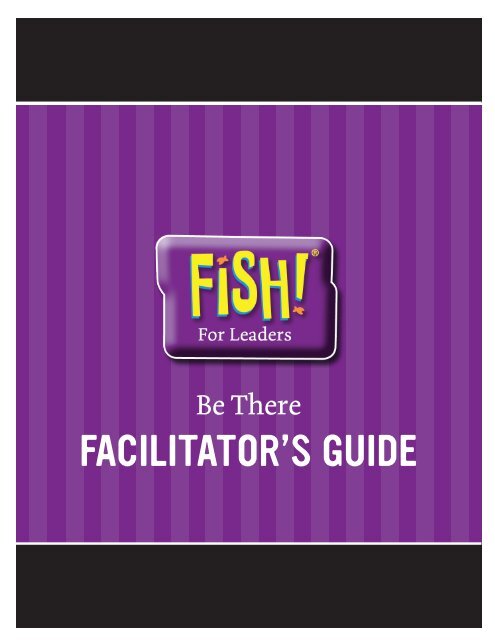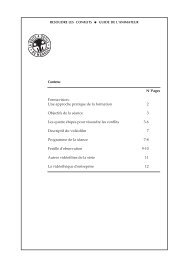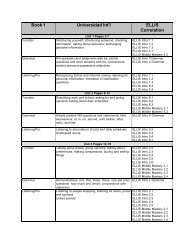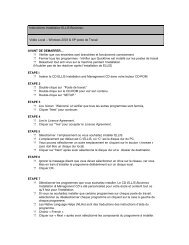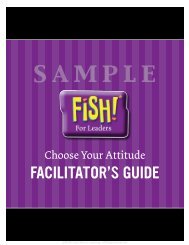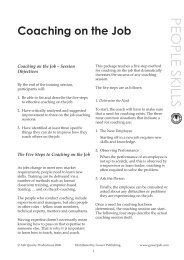Facilitator's guide
Facilitator's guide
Facilitator's guide
You also want an ePaper? Increase the reach of your titles
YUMPU automatically turns print PDFs into web optimized ePapers that Google loves.
Be There<br />
Facilitator’s <strong>guide</strong>
The FISH! For Leaders Series is dedicated to John Gardner,<br />
whose belief in human possibilities<br />
inspired several generations to believe in themselves.<br />
Produced and distributed by<br />
221 River Ridge Circle, Burnsville, MN 55337<br />
FISHPHILOSOPHY.COM<br />
800.328.3789<br />
Copyright© MMVII - MMX ChartHouse International Learning Corporation. All rights reserved.<br />
This book is the proprietary work of ChartHouse International Learning Corporation and is protected by international<br />
copyright laws. Any unauthorized use of this copyrighted material, terms and or/graphics, including commercial uses<br />
such as performances of ChartHouse works at trainings, facilitations, seminars or workshops; reproductions; storage<br />
in a retrievable system; or transmitted in any form or by any means—electronic, photo, mechanical, photocopying,<br />
recording or any other—except for the inclusion of brief quotations in printed reviews, is prohibited without<br />
ChartHouse International Learning Corporation’s prior signed, written agreement.<br />
FISH!; The FISH! Philosophy; JOY DESIGN; BLAX DESIGN; Be There, Play, Make Their Day, Choose Your Attitude; Who<br />
Are You Being While You’re Doing What You’re Doing are trademarks and/or registered trademarks of ChartHouse<br />
International Learning Corporation in the U.S. and other jurisdictions. For further information, contact ChartHouse<br />
International Learning Corporation, 221 River Ridge Circle, Burnsville, MN 55337; 800.328.3789<br />
2 FISH! For Leaders<br />
2
What is FISH! For Leaders?<br />
Early in his career, Carl Rogers, the noted psychologist, thought his job was to fix people. He asked<br />
himself, “How can I cure or change this person?”<br />
Despite his extensive training, it didn’t work. At times his tactics seemed to produce a change in<br />
people, but it was temporary at best.<br />
So Rogers tried a different approach. Instead of trying to mold his patients into who he wanted them<br />
to be, he focused on how he “showed up” for them. The more people saw that he cared about and<br />
believed in them, they discovered within themselves the capacity to change, mature and develop.<br />
Rogers’ experience speaks to the heart of leadership. Effective leaders don’t try to fix or control others.<br />
Instead, they ask themselves: “How can I develop relationships with the people I lead that help them<br />
grow in confidence, commitment, skill and purpose?”<br />
We created The FISH! For Leaders Series—of which this program is a part—to help you develop more<br />
supportive relationships through The FISH! Philosophy. These relationships are the foundation that<br />
make you more effective in every other aspect of your leadership.<br />
The FISH! Philosophy: Fundamentals For Leaders<br />
The roots of The FISH! Philosophy go back to the day John Christensen first visited the Pike Place Fish<br />
Market in Seattle. Selling fish was cold and exhausting, yet the fishmongers brought so much energy,<br />
commitment, service, teamwork and fun to the job that people came from around the world just to<br />
watch them sell fish—a lot of fish.<br />
John had always been fascinated by people who brought passion to their work, and saw the fish<br />
market as a metaphor to illustrate his belief that every workplace can be more alive and engaged.<br />
He made a film about the market to show everyone how to be more engaged in their work—and<br />
their lives. The film, FISH!, explores four simple practices that anyone, from frontline to CEO, can<br />
immediately apply:<br />
Be There: Be physically and emotionally present for people, especially when they need you. It’s a<br />
powerful message of respect that strengthens relationships.<br />
Be There : : Facilitator’s Guide<br />
3
What is FISH! For Leaders?<br />
Play: Play is a state of mind that you can apply to any task. It’s the spirit that fuels creativity, as in<br />
“Let’s Play with that idea!” You do your best work when you are having fun doing it.<br />
Make Their Day: Find ways to make people feel special, letting them know how much you value<br />
and appreciate them. Celebrate others.<br />
Choose Your Attitude: No matter what life throws in your path, you alone are responsible for how<br />
you respond to it.<br />
We call these four practices The FISH! Philosophy. Just as a tree needs healthy roots to bear good<br />
fruit, these practices nourish the roots of trust, communication, commitment and accountability.<br />
Organizations around the world are using The FISH! Philosophy to improve business results and<br />
create a higher quality of life at work. We have learned that organizations are most likely to succeed<br />
when leaders don’t simply expect their employees to live FISH!, but embrace these fundamental<br />
practices in their own lives first.<br />
Using this program, you will take your team through conversations and activities through which they<br />
will explore their leadership beliefs and style, consider their impact and learn how to lead even more<br />
effectively. Thank you for guiding them on this important journey.<br />
4<br />
4 FISH! For Leaders
Contents<br />
Be There .........................................................p. 6<br />
Leading This Program ............................................ p. 7<br />
Introducing the Video . . . . . . . . . . . . . . . . . . . . . . . . . . . . . . . . . . . . . . . . . . . . p. 8<br />
Conversation Starters . . . . . . . . . . . . . . . . . . . . . . . . . . . . . . . . . . . . . . . . . . . . p. 9<br />
Activities:<br />
• What’s My Impact? . . . . . . . . . . . . . . . . . . . . . . . . . . . . . . . . . . . . . . . . . p. 11<br />
• A Matter of Trust . . . . . . . . . . . . . . . . . . . . . . . . . . . . . . . . . . . . . . . . . . . p. 14<br />
• Finding Common Ground ...................................p. 16<br />
Follow-Up .......................................................p. 18<br />
Be There : : Facilitator’s Guide<br />
5
Be There<br />
A first grader once summed up Be There by saying, “It means no one ever has to be alone.”<br />
Suzi Wells, RN, manager of nurse triage services at St. Louis Children’s Hospital, wanted to make sure<br />
her staff didn’t feel alone. “I work weekdays, so I don’t always get to interact with all the nurses who<br />
work nights and weekends,” she says. “I wanted to reach out to them, so I committed to calling them<br />
regularly.<br />
“I was surprised by the apprehension in their voices when I started calling. One nurse asked, ‘I’m<br />
not in trouble, am I?’ Once they realized that I was calling to check in with them, not check up on<br />
them, they looked forward to our conversations. We really got to know one another. While my initial<br />
motivation was to help the nurses feel more connected to our department, I found that I needed and<br />
wanted those relationships just as much as they did.”<br />
As Suzi Wells proved, Be There goes beyond just being in the same room. You can sit a few feet from<br />
someone and fail to connect—like the restaurant manager who never turned around and kept typing<br />
when her employees came to her office to talk to her. “I thought I was multitasking,” she says. “But<br />
what I was really doing was alienating them.”<br />
Everyone gets distracted when they are trying to Be There. Sometimes the distractions are external<br />
(people, cell phones, computers) but often the noise comes from inside our heads. Maybe we are<br />
thinking about something that happened in the past or worrying about what might happen in the<br />
future. Perhaps we are judging what the other person is saying or preparing a brilliant response.<br />
It’s impossible to really listen if your mind is busy with concerns, fears or judgments. To truly Be<br />
There, you must be focused on the present. It means being open to what the other person is saying or<br />
feeling, what you might learn from them and how you might help them.<br />
The key to Be There is that people may not need you all the time. But when they do need you, they<br />
need all of you.<br />
“Good leaders must first become good servants.”<br />
—Robert Greenleaf<br />
6<br />
6 FISH! For Leaders
Leading This Program<br />
The resources in this <strong>guide</strong> were designed to lead a session from one to two hours, but you can easily<br />
adapt them to create a session of any length.<br />
1. Video<br />
Be There is 9 minutes in length. Key themes include:<br />
• How being there builds trust.<br />
• The impact of being present for those you lead.<br />
• Finding common ground.<br />
• Making an effort to get to know the people you lead.<br />
2. Conversation Starters<br />
Targeted questions, prompted by the video, help your group to begin exploring your beliefs about<br />
leadership. These questions help you to honestly assess whether the impact you are having is the<br />
impact you want to have.<br />
3. Activities<br />
Choose from several activities to help participants become engaged in their learning and take<br />
ownership of it. If you have purchased FISH! For Leaders Participant Workbooks for individual<br />
participants, we’ve provided page references so you can help them follow along during the session.<br />
Example: (If using Participant Workbook, see Workbook page 6.)<br />
4. Action Plan<br />
John Keats said, “Nothing becomes real until it is experienced.” Here your participants come up with<br />
their own plan to act on what they have learned. The actions may be simple: If you feel you haven’t<br />
been connecting with your colleagues, you might decide “the first thing I’ll do when I arrive in the<br />
morning is to greet every person in my area by name.”<br />
5. Tips<br />
If participants are not sure what to try or need more ideas, we’ve provided some suggestions.<br />
6. Follow-Up<br />
After you put your ideas into action, it helps to reflect on what you learned. What worked? What<br />
didn’t? What impact did it have on others? What impact did it have on you?<br />
Be There : : Facilitator’s Guide<br />
7
Introducing The Video<br />
Before your team watches Be There, it’s helpful to give some context. Here’s one way to introduce the<br />
film:<br />
Think for a few seconds about someone who is really there for you. Who is that? For me, it’s<br />
and they are there for me by<br />
. What does the person you are thinking of do<br />
to Be There for you?<br />
As you think about that person, what’s their impact on you? I’ll bet there’s a high level of trust. And that’s<br />
critical for leaders—because you can’t lead without earning trust. A lot of things go into maintaining trust, but<br />
it starts with being there.<br />
As we watch the video, ask yourself, “What am I doing to Be There for the people I lead?<br />
8<br />
8 FISH! For Leaders
Conversation Starters<br />
We included lots of questions to prompt discussion, but don’t feel you have to get through every<br />
question in one session. You may want to choose two to three questions and if you have time for<br />
more, go for it. If a particular question really ignites discussion, don’t feel you have to move on<br />
immediately to the next question. Go with the energy of the group. Keep the conversation going with<br />
statements such as, “Tell me more about that.”<br />
1.<br />
What stood out for you in the video? Are there any stories or insights you might apply to your<br />
own leadership?<br />
2.<br />
Who is there for you most often? What do they do to Be There for you? How would they say you<br />
are being there for them?<br />
3.<br />
Bob Deaton talks about how he used to brush people off when he was busy. What gets in the way<br />
of you being there for others?<br />
4.<br />
What would you gain by setting aside for a moment the things that keep you from being there?<br />
What might you miss if you don’t?<br />
5.<br />
JP from Pike Place Fish Market says, “If I want people to trust me and value my presence, I’d<br />
better trust them and value their presence.” What does it look like when you sincerely trust your<br />
employees and value their presence?<br />
6.<br />
Johnny Yokoyama says it’s important to listen to employees so “I don’t get in their way.” What do<br />
you think he means? How do your thoughts, opinions or agendas get in the way of listening?<br />
7.<br />
When Rob Gregory talks about “getting inside” someone else’s head, what does he mean? How<br />
does that benefit you? How does it benefit the other person?<br />
8.<br />
As you watch Herb Kelleher Be There, what are some of things he does that helps him connect<br />
with people? What effect do you think this has on them?<br />
Be There : : Facilitator’s Guide<br />
9
Conversation Starters<br />
9.<br />
Matt says of Herb Kelleher, “The nice thing about working here is that my CEO knows that my<br />
name is Matt, I work on the fourth floor and I wear crazy T-shirts.” How does getting to know<br />
people help you lead more effectively? What can you do to get to know them better?<br />
10.<br />
People seem comfortable being around the leaders in the video, especially Herb Kelleher, because<br />
the leaders are comfortable being themselves.<br />
• When you are really being yourself at work, what does that look like?<br />
• How does it help you as a leader?<br />
• Is there ever a time when you feel you can’t be yourself at work? Why?<br />
10<br />
10 FISH! For Leaders
Activity #1: What’s my Impact?<br />
In the video, Bob Deaton says he used to be so focused on his own work that when people came to him<br />
with a question, he “blew them off without even realizing it.” The concept of Be There helped Bob<br />
recognize the importance of taking time for others when they needed him.<br />
Months later, when Bob saw another manager “walking past people without acknowledging them,<br />
being in a hurry with folks,” he used himself as an example. “You have Bob Deaton syndrome,” Bob<br />
told him. “You’re being just like I was.”<br />
“That really hits home, because I know how I felt about you,” the manager responded. “I was afraid to<br />
come near you.”<br />
It’s easy to come up with good reasons why we can’t Be There for others: too much work, unanswered<br />
emails, another meeting. But no matter how valid it appears, the choice not to Be There has an<br />
undeniable impact on the people we lead—and on our ability to lead them.<br />
Instructions<br />
The following exercise reminds people of the impact of not being there. It’s also a good way to build<br />
connections between participants. Allow 15-20 minutes for the activity.<br />
1. Pair participants with someone they don’t know, no trios if possible. Be sure they learn each<br />
other’s names.<br />
2.<br />
In a fun way (tallest/shortest, similar birthdays) assign one member of the pair as Partner A and<br />
the other as Partner B.<br />
3.<br />
Ask Partner A to share with Partner B a story or thoughts about someone (family, friend) who is<br />
very special to them and why they are special.<br />
4.<br />
Tell Partner B to do everything they can think of (looking away, checking cell phone, acting<br />
impatient) to NOT Be There for Partner A. You may acknowledge this before Partner A begins<br />
by having Partner B look at A and say, “I’m sorry.” They’ll probably laugh and feel relieved. Or, if<br />
you’re brave, don’t tell Partner A what B is going to do.<br />
Be There : : Facilitator’s Guide<br />
11
Activity #1: What’s my Impact? (continued)<br />
5.<br />
Tell Partner A to start. After 30-60 seconds call “Stop,” and ask the following:<br />
• Of the As…<br />
- Who felt frustrated? Why?<br />
- Who gave up? Why?<br />
- How did they feel about B because of their behavior?<br />
• Of the Bs…<br />
- Who felt bad or guilty? Why?<br />
- Did anyone secretly try to listen while pretending to not Be There? Why?<br />
6. Have Partner A tell their story again and this time have Partner B to really Be There.<br />
• After 30-60 seconds call “Stop,” and have a few individuals share:<br />
- What was different this time?<br />
- How did the A’s feel about their partners this time?<br />
- How did the B’s feel about their impact?<br />
- How can you Be There more consistently in your work and life?<br />
(If using Participant Workbook, see page 6. Ask participants to write what they learned during this<br />
activity.)<br />
Action Plan<br />
Ask participants, “What impact do you want to have on the people in your life by being there? What<br />
will you do in the next week to have that impact? Write what you will do and when you will do it.”<br />
(If using Participant Workbook, see Workbook page 6.)<br />
Tips<br />
• If you really want to know your impact, go directly to the source. Talk to three team members and<br />
say you want to be more present. Ask them to tell you honestly—bluntly, if need be—about a time<br />
or times you weren’t physically or mentally present for them. Ask: “What impact did that have on<br />
you? What can I do to Be There more for you?” Thank them sincerely for their help; their feedback<br />
is helping you to build stronger relationships.<br />
• Make it a habit after meetings to ask people who were there: “What was my impact in the meeting?”<br />
Ask them to be as specific as possible—it might be the way you drew someone into the meeting by<br />
12<br />
12 FISH! For Leaders
Activity #1: What’s my Impact? (continued)<br />
asking questions, the way you encouraged someone whose confidence seemed to lag, how you kept<br />
your cool during a tense exchange. As your awareness grows, the more prepared you’ll be to show<br />
up in a way that creates the impact you want.<br />
Be There : : Facilitator’s Guide<br />
13
Activity #2: A Matter of Trust<br />
John Gardner observed, “It is virtually impossible to lead a non-community.” The people you lead<br />
may admire your business skill. They may respect your experience. They may be attracted by your<br />
charisma. But until you give something of yourself to them, to make time to “be” with them, you<br />
won’t win their trust. People can’t trust you if they don’t know you.<br />
Being there for others transforms mistrust into teamwork, individualism into shared vision. It’s the<br />
difference between people feeling that they work with you, not for you.<br />
Instructions<br />
Ask the group to fill out on flipchart paper or white board: On a scale of 1 to 10, how much do our<br />
team members trust us?<br />
(If using Participant Workbook, see Workbook page 8.)<br />
Low Trust<br />
High Trust<br />
1 2 3 4 5 6 7 8 9 10<br />
Ask the group to answer:<br />
• Why are we at the trust level we wrote down?<br />
• What are we doing—or failing to do—that contributes to that trust level?<br />
• Where do we want that trust level to be next month, quarter or year? (It’s important to set<br />
some time frame as a goal. While 10 may be the obvious goal, if trust is low now, it may be more<br />
realistic to aim initially for a 7 or 8.)<br />
• What will be different when we reach the trust level we want? What will we do<br />
differently than we do now?<br />
Action Plan<br />
Ask participants, “What are some things you will do to build trust with your team members? Write<br />
what you will do and when you will do it.”<br />
(If using Participant Workbook, see Workbook page 8.)<br />
14<br />
14 FISH! For Leaders
Activity #2: A Matter of Trust (continued)<br />
Tips<br />
• To build trust, make these basic Be There actions a habit:<br />
- When people enter your office or cubicle, turn away from what you are working on and face<br />
them.<br />
- Before starting a conversation, let the other person know if you are expecting a call you<br />
must take.<br />
- Tell people how much time you have to talk and ask if it’s sufficient. When you need to talk,<br />
ask, “Is this a good time?”<br />
- Wait for others to finish their thoughts before you speak.<br />
• One way to Be There more consistently is to be curious. Being curious about what others are saying<br />
gets you out of your own world and into theirs. Curious questions don’t just seek information. They<br />
help you find out more about what the person thinks, feels and values. Next week, when you ask,<br />
“How was your weekend?” and the other person says, “Great,” don’t just stop there. Ask, “What<br />
was great about it?” When someone tells you about a problem they are trying to solve or a project<br />
they are working on, ask what is important to them about it, their thoughts on it, how would<br />
solving it make the workplace better. Try not to make any statements for a few minutes—just ask<br />
questions. It’s not an interrogation, but a way to let the other person know they are being heard and<br />
acknowledged.<br />
Be There : : Facilitator’s Guide<br />
15
Activity #3: Finding Common Ground<br />
Before you can lead others to a goal, you must first seek to understand how they see themselves in the<br />
world you wish to create. According to Annette Simmons, author of The Story Factor, it means paying<br />
attention to “the stories they tell themselves about you” as well as “the stories you are telling yourself<br />
about them.”<br />
Rob Gregory, the owner of a car dealership, admits in the video that he didn’t treat technicians the<br />
same way he did salespeople. He didn’t identify with them and they didn’t trust him. But he had a new<br />
vision for how he wanted his business to operate and recognized that to bring them onboard, he must<br />
first see the business through their eyes.<br />
Rob and the technicians began to meet regularly. Rob says one of the best things that happened was<br />
“getting inside” each other’s head to understand what each of them “deal with.” Wayne, one of the<br />
technicians, realized he and Rob were “the same” because they both wanted to serve people. As they<br />
shared their perspectives, they found common ground on which they could trust each other and work<br />
together.<br />
Instructions<br />
Here’s an exercise to help you understand the perspective of others.<br />
1.<br />
Write the names of different departments or functions—marketing, product development, sales,<br />
etc.—on pieces of paper and tape them to chairs.<br />
2.<br />
Have people sit in a chair representing a function that is not their own.<br />
3.<br />
Have the group come up with a theoretical problem to be solved or issue to be improved.<br />
4.<br />
Ask participants to think about the problem from the perspective of the function in whose<br />
chair they sit. To vary your learning even more, have participants shift to a new chair every five<br />
minutes.<br />
5.<br />
Then take off the pieces of paper and shift to thinking from your own perspectives.<br />
16<br />
16 FISH! For Leaders
Activity #3: Finding Common Ground (continued)<br />
6.<br />
Consider: What did we learn? Where do we go from here?<br />
(If using Participant Workbook, see page 10.)<br />
Action Plan<br />
Ask participants, “What will you do to consider and recognize the ideas and perspectives of others?<br />
Write what you will do and when you will do it.”<br />
(If using Participant Workbook, see page 10.)<br />
Tips<br />
• If you want to learn more about a team or department with whom you do not feel you are on<br />
common ground, schedule a meeting with someone from that department or invite them out for<br />
lunch. Don’t talk about your differences. Get curious: Ask about what they do, how they do it, why<br />
they do it. Find out who they are. Listen specifically for areas in which you have similar ideas, goals,<br />
processes or values.<br />
• Think about a person from whom you don’t normally seek input. Step outside your comfort zone<br />
and ask them for their thoughts on an issue you are dealing with or a project you’re working on.<br />
Besides strengthening your relationship, you are learning a different perspective.<br />
• When you stop by a team member’s workspace, pay attention to things that are clearly or<br />
prominently displayed on their desk or wall. If it’s a picture, ask who’s in it. If you already know<br />
who’s in the picture, ask how they are. If it is an object, ask why it is significant. Ask a few questions<br />
about what you’ve noticed. If your questions lead them to tell a story, listen and thank them for<br />
sharing. Try this once a day with a different employee. You will learn a little more about what’s<br />
important to them.<br />
• Get to know each other better by starting a “Who I Am” bulletin board. Ask employees to bring in<br />
pictures of their families, themselves as a baby or participating in a favorite hobby, their favorite art<br />
or a personally meaningful quote. Make sure to save a place for yourself on the board too.<br />
Be There : : Facilitator’s Guide<br />
17
Follow-Up<br />
1.<br />
If your team has a regularly scheduled meeting, check in with participants next time you get<br />
together. Review what they wrote in their action plans/commitments. Ask:<br />
• What new things did you do?<br />
• What happened?<br />
• What was the impact on others?<br />
• What was the impact on you?<br />
2. To remind participants of your Be There conversations and their action plans, send them<br />
occasional emails of the Tips from the end of each section.<br />
18<br />
18 FISH! For Leaders
FISH! For Leaders Series<br />
The FISH! For Leaders Series consists of six programs, each of which helps leaders to be more<br />
effective by applying one aspect of The FISH! Philosophy. Use any combination of these six thoughtprovoking<br />
programs to create the leadership training that fits your team’s needs.<br />
FISH! For Leaders programs include:<br />
It Starts with Me<br />
The secret to outstanding leadership is not in what you command others to do for you, but what you<br />
inspire them to do through your example.<br />
Be There<br />
People may admire your talent, charisma and business skill, but they will not really trust you until<br />
you make the effort to be present for them, emotionally as well as physically.<br />
Play<br />
You can’t just order creativity like a lunch special or install happiness like a program. To enjoy the<br />
many business and human benefits of Play, leaders must first nurture an environment that is full of<br />
trust and respect, and free of fear.<br />
Make Their Day<br />
One of the best ways for a leader to make someone’s day—or month, or year, or life—is to value them.<br />
Simple gestures, such as appreciation and giving people a voice, fulfill emotional needs that are too<br />
often ignored on the job.<br />
Choose Your Attitude<br />
Your attitude has a powerful effect on the people you lead. What impact do you want to have on<br />
others? You alone are responsible for choosing the attitude that will achieve that impact.<br />
Who Are You Being?<br />
Great leaders are <strong>guide</strong>d by what they stand for, not by the temporary ups and downs happening<br />
around them. To lead more intentionally, you must define your purpose, recommit to it every day and<br />
ask others to help you be the person you say you want to be.<br />
Be There : : Facilitator’s Guide<br />
19


